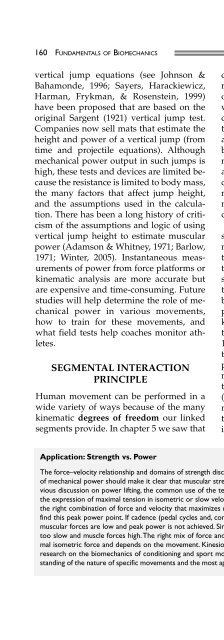Fundamentals of Biomechanics
Fundamentals of Biomechanics
Fundamentals of Biomechanics
Create successful ePaper yourself
Turn your PDF publications into a flip-book with our unique Google optimized e-Paper software.
160 FUNDAMENTALS OF BIOMECHANICS<br />
vertical jump equations (see Johnson &<br />
Bahamonde, 1996; Sayers, Harackiewicz,<br />
Harman, Frykman, & Rosenstein, 1999)<br />
have been proposed that are based on the<br />
original Sargent (1921) vertical jump test.<br />
Companies now sell mats that estimate the<br />
height and power <strong>of</strong> a vertical jump (from<br />
time and projectile equations). Although<br />
mechanical power output in such jumps is<br />
high, these tests and devices are limited because<br />
the resistance is limited to body mass,<br />
the many factors that affect jump height,<br />
and the assumptions used in the calculation.<br />
There has been a long history <strong>of</strong> criticism<br />
<strong>of</strong> the assumptions and logic <strong>of</strong> using<br />
vertical jump height to estimate muscular<br />
power (Adamson & Whitney, 1971; Barlow,<br />
1971; Winter, 2005). Instantaneous measurements<br />
<strong>of</strong> power from force platforms or<br />
kinematic analysis are more accurate but<br />
are expensive and time-consuming. Future<br />
studies will help determine the role <strong>of</strong> mechanical<br />
power in various movements,<br />
how to train for these movements, and<br />
what field tests help coaches monitor athletes.<br />
SEGMENTAL INTERACTION<br />
PRINCIPLE<br />
Human movement can be performed in a<br />
wide variety <strong>of</strong> ways because <strong>of</strong> the many<br />
kinematic degrees <strong>of</strong> freedom our linked<br />
segments provide. In chapter 5 we saw that<br />
Application: Strength vs. Power<br />
coordination <strong>of</strong> these kinematic chains<br />
ranges along a continuum from simultaneous<br />
to sequential. Kinetics provides several<br />
ways in which to examine the potential<br />
causes <strong>of</strong> these coordination patterns. The<br />
two expressions <strong>of</strong> Newton's second law<br />
and the work–energy relationship have<br />
been employed in the study <strong>of</strong> the coordination<br />
<strong>of</strong> movement. This section proposes<br />
a Principle <strong>of</strong> Segmental Interaction that<br />
can be used to understand the origins <strong>of</strong><br />
movement so that pr<strong>of</strong>essionals can modify<br />
movement to improve performance and reduce<br />
risk <strong>of</strong> injury.<br />
The Segmental Interaction Principle<br />
says that forces acting between the segments<br />
<strong>of</strong> a body can transfer energy between<br />
segments. The biomechanics literature<br />
has referred to this phenomenon in<br />
several ways (Putnam, 1993). The contribution<br />
<strong>of</strong> body segments to movement has<br />
been called coordination <strong>of</strong> temporal impulses<br />
(Hochmuth & Marhold, 1978), the<br />
kinetic link principle (Kreighbaum & Barthels,<br />
1996), summation <strong>of</strong> speed (Bunn,<br />
1972), summation or continuity <strong>of</strong> joint<br />
torques (Norman, 1975), the sequential or<br />
proximal-to-distal sequencing <strong>of</strong> movement<br />
(Marshall & Elliott, 2000), and the<br />
transfer <strong>of</strong> energy or transfer <strong>of</strong> momentum<br />
(Lees & Barton, 1996; Miller, 1980). The<br />
many names for this phenomenon and the<br />
three ways to document kinetics are a good<br />
indication <strong>of</strong> the difficulty <strong>of</strong> the problem<br />
The force–velocity relationship and domains <strong>of</strong> strength discussed in chapter 4, as well as this chapter's discussion<br />
<strong>of</strong> mechanical power should make it clear that muscular strength and power are not the same thing. Like the previous<br />
discussion on power lifting, the common use <strong>of</strong> the term power is <strong>of</strong>ten inappropriate. Muscular strength is<br />
the expression <strong>of</strong> maximal tension in isometric or slow velocities <strong>of</strong> shortening.We have seen that peak power is<br />
the right combination <strong>of</strong> force and velocity that maximizes mechanical work. In cycling, the gears are adjusted to<br />
find this peak power point. If cadence (pedal cycles and, consequently, muscle velocity <strong>of</strong> shortening) is too high,<br />
muscular forces are low and peak power is not achieved. Similarly, power output can be submaximal if cadence is<br />
too slow and muscle forces high.The right mix <strong>of</strong> force and velocity seems to be between 30 and 70% <strong>of</strong> maximal<br />
isometric force and depends on the movement. Kinesiology pr<strong>of</strong>essionals need to keep up with the growing<br />
research on the biomechanics <strong>of</strong> conditioning and sport movements. Future research will help refine our understanding<br />
<strong>of</strong> the nature <strong>of</strong> specific movements and the most appropriate exercise resistances and training programs.






